Chapter Two — The Canadian Military Justice System: Structure and Statistics
Canada’s military justice system is a separate and parallel system of justice that forms an integral part of the Canadian legal mosaic. It shares many of the same underlying principles as the civilian criminal justice system and it is subject to the same constitutional framework, including the Canadian Charter of Rights and Freedoms. On more than one occasion, the Supreme Court of Canada has directly addressed the requirement of a separate, distinct military justice system to meet the specific needs of the Canadian Armed Forces.Footnote 5
The military justice system is designed to promote the operational effectiveness of the Canadian Armed Forces by contributing to the maintenance of discipline, efficiency, and morale, while ensuring that justice is administered fairly and with respect to the rule of law. These objectives give rise to many of the substantive and procedural differences that properly distinguish the military justice system from the civilian justice system.
The Structure of the Military Justice System
The Code of Service Discipline
The Code of Service Discipline, Part III of the National Defence Act, is the foundation of the military justice system. It sets out disciplinary jurisdiction and provides for service offences that are essential to the maintenance of discipline and the operational effectiveness of the Canadian Armed Forces. It also sets out the procedures and organization of service tribunals, the jurisdiction of various actors in the military justice system, powers of punishment, post-trial review and appeal mechanisms.
The term “service offence” is defined in the National Defence Act as “an offence under this Act, the Criminal Code or any other Act of Parliament, committed by a person while subject to the Code of Service Discipline.” Thus, service offences include many disciplinary offences that are unique to the profession of arms, such as disobedience of a lawful command, absence without leave, and conduct to the prejudice of good order and discipline, in addition to more conventional offences such as those found in the Criminal Code and other Acts of Parliament. Members of the Regular Force of the Canadian Armed Forces are subject to the Code of Service Discipline everywhere and at all times, whereas members of the Reserve Force are subject to the Code of Service Discipline only in the circumstances specified in the National Defence Act.
The Two Tiers of the Military Justice System
The military justice system has a tiered tribunal structure comprised of two types of service tribunals: summary trials and courts martial. The Queen’s Regulations and Orders for the Canadian Forces outline procedures for the disposal of a charge by each type of service tribunal.
Summary Trials
The summary trial is the most common form of service tribunal. It allows for relatively minor service offences to be tried and disposed of quickly at the unit level. Summary trials are presided over by members of the chain of command, who are trained and certified by the Judge Advocate General as qualified to perform their duties as presiding officers in the administration of the Code of Service Discipline.Footnote 6 All accused members are entitled to an assisting officer in the preparation of their case, during the summary trialFootnote 7 and in the preparation of a post-trial review request.Footnote 8
The procedures at summary trial are straightforward and the powers of punishment are limited. This limitation reflects both the relatively minor nature of the offences involved, and the intent that the punishments be primarily corrective in nature.
After a charge is laid, if it is determined that the accused can be tried by summary trial then, except in certain circumstances, an accused person has a right to be offered an election to be tried by court martial.Footnote 9 The election process was designed to provide the accused with the opportunity to make an informed choice regarding which type of service tribunal will try the matter.
The jurisdiction of an officer presiding at summary trial is limited by factors such as the rank of the accused and the type of offences. All service offences may be tried by court martial; however, those listed in paragraphs 108.07(2) and 108.07(3) of the Queen’s Regulations and Orders for the Canadian Forces may also be tried by summary trial. Service members at or above the rank of Colonel cannot be tried by summary trial.Footnote 10
The disposition of charges by summary trial is meant to occur expeditiously. Unless they waive the limitation periods, an accused person may not be tried by summary trial unless the charge is laid within six months after the day on which the service offence is alleged to have been committed and unless the summary trial commences within one year after that day.Footnote 11
Review of a Finding Made and/or Sentence Imposed at Summary Trial
A member of the Canadian Armed Forces found guilty of a service offence at summary trial has the right to apply to a review authority for a review of the findings, the punishment imposed, or both. The findings made and/or punishments imposed at summary trial may also be reviewed on the independent initiative of a review authority. A review authority is a more senior officer in the chain of command of the officer who presided over the summary trial, as designated by the Queen’s Regulations and Orders for the Canadian Forces. A review authority may quash any findings of guilt made at summary trial, substitute any finding of guilt or punishment, or may mitigate, commute or remit any punishment awarded at summary trial. Before making any determination, a review authority must obtain legal advice.Footnote 12
Courts Martial
The court martial – a formal military court presided over by a Military Judge – is designed to deal with more serious offences and has powers of punishment up to and including imprisonment for life. Courts martial are conducted in accordance with rules and procedures similar to those of civilian criminal courts and have the same rights, powers and privileges as a superior court of criminal jurisdiction with respect to all “matters necessary or proper for the due exercise of [their] jurisdiction.”Footnote 13
The National Defence Act provides for two types of courts martial: General and Standing. These courts martial can be convened anywhere, in Canada and abroad. The General Court Martial is composed of a military judge and a panel of five Canadian Armed Forces members. The panel serves as the trier of fact and decides unanimously on any finding of guilty or not guilty, of unfitness to stand trial or of not responsible on account of mental disorder. A decision in respect of any other matter is determined by a majority vote. The military judge determines the sentence in the event of a finding of guilt or directs the person be discharged absolutely.Footnote 14 At a Standing Court Martial, the military judge sits alone, makes any required findings and, if the accused person is found guilty, imposes the sentence or directs the person be discharged absolutely.
In cases that cannot be dealt with by summary trial, the matter is referred to the Director of Military Prosecutions, who determines whether or not to prefer the case for trial by court martial. At a court martial, the prosecution is conducted by a military prosecutor under the authority of the Director of Military Prosecutions. The accused is entitled to be represented by defence counsel assigned by the Director of Defence Counsel Services at no cost, or by civilian counsel at his or her own expense. The accused can also choose not to be represented by a lawyer.
Appeal of a Court Martial Decision
Decisions made at courts martial may be appealed to the Court Martial Appeal Court of Canada by the person subject to the Code of Service Discipline or by the Minister or counsel instructed by the Minister.Footnote 15 The Court Martial Appeal Court of Canada is composed of civilian judges who are appointed by the Governor in Council from the Federal Court of Appeal, the Federal Court, or from the superior courts and courts of appeal of the provinces and territories.
Court Martial Appeal Court of Canada decisions may be appealed to the Supreme Court of Canada on any question of law on which a judge of the Court Martial Appeal Court of Canada dissents, or on any question of law if leave to appeal is granted by the Supreme Court of Canada.
Statistics
A number of factors can contribute to variations in statistics reported in this chapter. Due to limitations in statistical analysis capabilities available during the reporting period it is not possible, at this time, to conclusively determine specific reasons for statistical variations. However, the Justice Administration Information Management System and the Military Justice System Performance Monitoring Framework will electronically track discipline files from the time a complaint is received to the time a file is closed, and will deliver measureable data on the performance of the military justice system, allowing for the identification of trends, emerging issues and other factors contributing to changes in statistics. The Justice Administration Information Management System and the Military Justice System Performance Monitoring Framework are scheduled to be operational in the next reporting period and are discussed in further detail in Chapter Three.
Summary Trials
Number of Summary Trials
Summary trials continue to be the most widely used form of service tribunal in the Canadian Armed Forces to deal with service offences under the Code of Service Discipline. During this reporting period, there were 533 summary trials in comparison to 51 courts martial. Summary trials made up approximately 91% of trials held before service tribunals. Figure 2-1 shows the number of summary trials and courts martial for the last two reporting periods as well as the corresponding percentage of cases tried by each type of service tribunal and Figure 2-2 shows the total number of summary trials by reporting period since 2014/15.
Figure 2-1: Distribution of Service Tribunals
| 2017/18Footnote16 | 2018/19 | |||
|---|---|---|---|---|
| # | % | # | % | |
| Number of Courts Martial | 62 | 9.00 | 51 | 8.73 |
| Number of Summary Trials | 627 | 91.00 | 533 | 91.27 |
| Total | 689 | 100 | 584 | 100 |
Figure 2-2: Graph breakdown
| 2014/15 | 2015/16 | 2016/17 | 2017/18 | 2018/19 | |
|---|---|---|---|---|---|
| Number of Summary Trials | 857 | 756 | 614 | 627 | 533 |
Figure 2-3 shows the total number of summary trials for the last two reporting periods by organization and Figure 2-4 illustrates the number of summary trials specifically for the Canadian Army, the Royal Canadian Navy, the Chief of Military Personnel, the Canadian Joint Operations Command, and the Royal Canadian Air Force since 2014/15.
For the Canadian Army, in this reporting period, there were a total of 209 summary trials as opposed to 240 for the previous reporting period. That is a decrease of 31 summary trials which represents a decrease of approximately 13% in comparison to the previous reporting period. Since 2014/15 there has been a decrease in the number of summary trials within the Canadian Army for each reporting period.
The Royal Canadian Navy has seen a fluctuation in the total number of summary trials since the 2014/15 reporting period. An increase of 43% in the number of summary trials occurred during the 2015/16 reporting period, while the reporting periods 2016/17 and 2017/18 remained steady after a 24% decrease from 2015/2016. In this reporting period, there was an additional decrease of 46 summary trials, or a decrease of 32.62%, from the 2017/18 reporting period.
Figure 2-3: Number of Summary Trials by Organization
| 2017-2018 | 2018-2019 | |||
|---|---|---|---|---|
| # | % | # | % | |
| Canadian Army | 204 | 38.28 | 209 | 39.21 |
| Royal Canadian Navy | 141 | 22.49 | 95 | 17.82 |
| Chief of Military Personnel | 118 | 18.82 | 117 | 21.95 |
| Royal Canadian Air Force | 60 | 9.57 | 55 | 10.32 |
| Canada Joint Operations Command | 48 | 7.65 | 39 | 7.32 |
| Canada Special Operations Forces Command | 11 | 1.75 |
11 | 2.06 |
| Vice Chief of the Defence Staff | 3 | 0.48 | 3 | 0.56 |
| Assistant Deputy Minister (Material) | 2 | 0.32 | 1 | 0.19 |
| Assistant Deputy Minister (Infrastructure and Environment) | 2 | 0.32 | 0 | 0.00 |
| Assistant Deputy Minister (Information Management) | 1 | 0.16 | 1 | 0.19 |
| Canadian Forces Intelligence Command | 1 | 0.16 | 1 | 0.19 |
| Office of the Judge Advocate General | 1 | 0.16 | 1 | 0.19 |
| Total | 627 | 100 | 533 | 100 |
Figure 2-4: Number of Summary Trials for the Canadian Army, the Royal Canadian Navy, the Chief of Military Personnel, the Canadian Joint Operations Command and the Royal Canadian Air Force
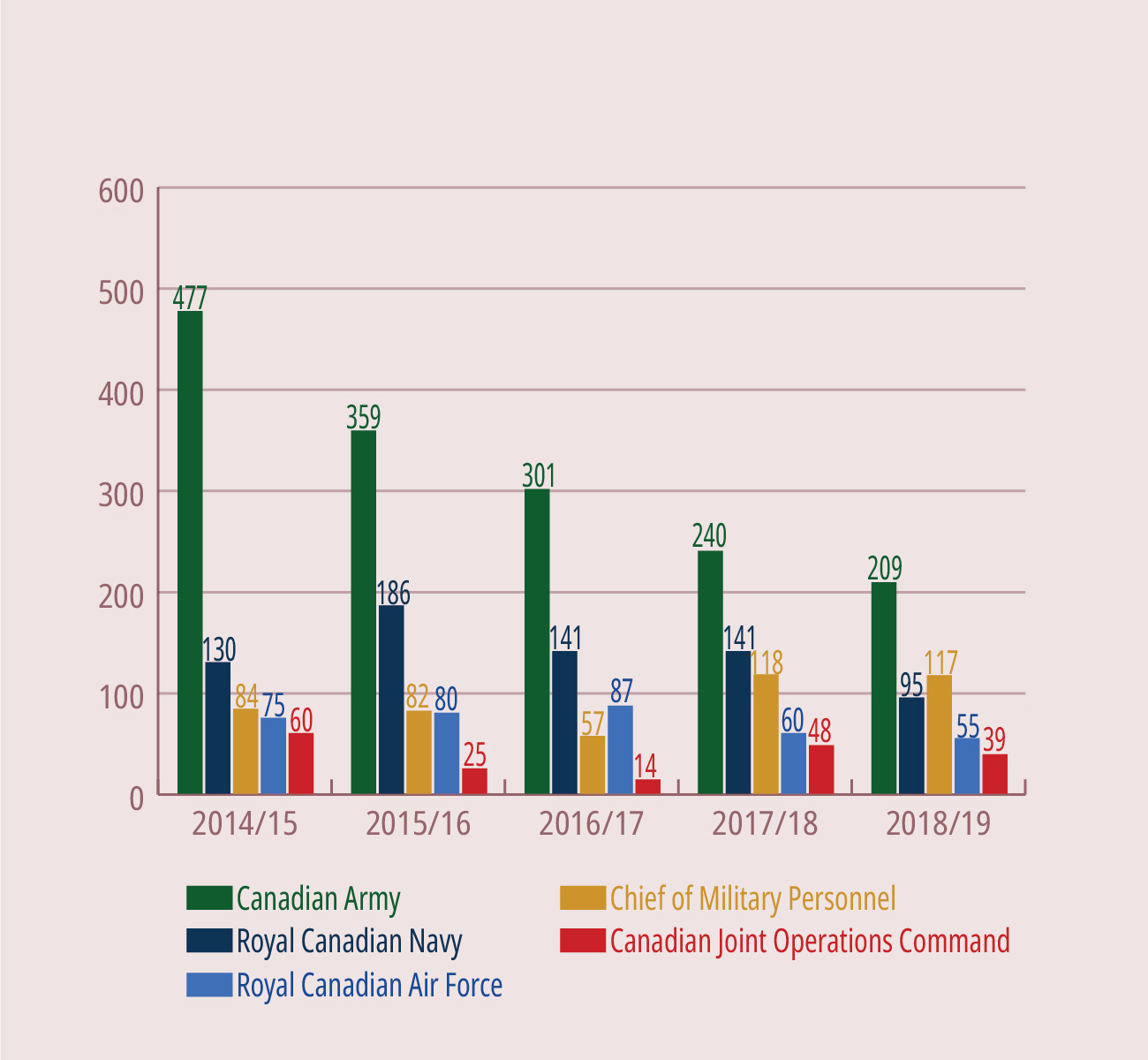
Figure 2-4: Graph breakdown
| 2014/15 | 2015/16 | 2016/17 | 2017/18 | 2018/19 | |
|---|---|---|---|---|---|
| Canadian Army | 477 | 359 | 301 | 240 | 209 |
| Royal Canadian Navy | 130 | 186 | 141 | 141 | 95 |
| Chief of Military Personnel | 84 | 82 | 57 | 118 | 117 |
| Royal Canadian Air Force | 75 | 80 | 87 | 60 | 55 |
| 60 | 25 | 14 | 48 | 39 |
For this reporting period, the Canadian Joint Operations Command had 39 summary trials, a decrease of nine summary trials from the previous reporting period, representing an approximate decrease of 19%.
For the Royal Canadian Air Force, there were five fewer summary trials, for a total of 55, representing approximately an 8% decrease in the total number of summary trials in comparison to the previous reporting period.
Finally, the Chief of Military Personnel had one less summary trial this reporting period, for a total of 117, representing a 0.85% decrease, in comparison to the last reporting period.
Number of Charges Disposed of at Summary Trial
In this reporting period, there were a total of 742 charges disposed of at summary trial compared to 842 charges disposed of at summary trial during the 2017/18 reporting period. Figure 2-5 shows the total number of charges disposed of at summary trial since 2014/15, which demonstrates a consistent decrease in the overall number of charges disposed of at summary trial.
Figure 2-5: Number of Charges Disposed of at Summary Trial

Figure 2-5: Graph breakdown
| 2014/15 | 2015/16 | 2016/17 | 2017/18 | 2018/19 | |
|---|---|---|---|---|---|
| Number of Charges Disposed of at Summary Trial | 1225 | 1130 | 911 | 842 | 742 |
The two most common types of offences which account for approximately 71% of all charges at summary trial are absence without leave and conduct to the prejudice of good order and discipline.Footnote 17
Since the 2014/15 reporting period there has been a consistent decline in the total number of charges reported for absence without leave. In the current reporting period the total number was 274 compared to 475 charges for absence without leave in the 2014/15 reporting period.
In this reporting period there were a total of 256 charges for the offence of conduct to the prejudice of good order and discipline. This is an increase compared to the previous reporting period of 237 charges, or 8%. Figure 2-6 shows the number of charges for absence without leave and conduct to the prejudice of good order and discipline between 2014/15 and 2018/19.
Figure 2-6: Number of Charges for Absence without Leave and Conduct to the Prejudice of Good Order and Discipline

Figure 2-6: Graph breakdown
| 2014/15 | 2015/16 | 2016/17 | 2017/18 | 2018/19 | |
|---|---|---|---|---|---|
| Absence without Leave | 475 | 470 | 429 | 312 | 274 |
| Conduct to the Prejudice of Good Order and Discipline | 404 | 317 | 140 | 237 | 256 |
Number of Elections to be Tried by Court Martial
Pursuant to Queen’s Regulations and Orders for the Canadian Forces article 108.17, an accused person has the right to elect to be tried by court martial rather than summary trial except where the accused: (1) has been charged with one of five minor service offences; and (2) the circumstances surrounding the commission of the offence are sufficiently minor in nature that the officer exercising summary trial jurisdiction over the accused concludes that a punishment of detention, reduction in rank or a fine in excess of 25% of the accused’s monthly basic pay would not be warranted if the accused were found guilty of the offence.
The five minor offences are: (1) insubordinate behaviour, (2) quarrels and disturbances, (3) absence without leave, (4) drunkenness, and (5) conduct to the prejudice of good order and discipline where the offence relates to military training, maintenance of personal equipment, quarters or work space, or dress and deportment.Footnote 18
During this reporting period, 192 elections to be tried by court martial were offered to accused members. Of the 192 elections offered, 145 accused members elected to be tried by summary trial, representing 75.52% of the total elections offered. Of these 145 elections to summary trial, one matter was directly referred to the Director of Military Prosecutions for preferral, because the election had been offered to the accused member in error by the unit. In one other matter, the charge was not proceeded with by the commanding officer. In total, 153 summary trials were completed within this reporting period, where an election was offered, 10 of which were the result of an election offered in the 2017-18 reporting period.
In the current reporting period, 47 accused elected to be tried by court martial, representing 24.48% of the elections offered. Figure 2-7 represents the percentage of accused persons electing court martial when an election was offered over the past five reporting periods.
Figure 2-7: Percentage of Accused Electing to be Tried by Court Martial

Figure 2-7: Graphis breakdown
| 2014/15 | 2015/16 | 2016/17 | 2017/18 | 2018/19 | |
|---|---|---|---|---|---|
| Percentage of Accused Electing to be Tried by Court Martial | 21.48 | 23.36 | 24.09 | 22.38 | 24.48 |
Figure 2-8 shows the number of summary trials completed for the past five reporting periods in which the accused person was offered an election as well as the number of summary trials in which no election was offered. Figure 2-9 shows the percentage of summary trials completed per reporting period where an accused was offered an election.
Figure 2-8: Graphic breakdown
| 2014/15 | 2015/16 | 2016/17 | 2017/18 | 2018/19 | |
|---|---|---|---|---|---|
| Election Not Offered | 601 | 526 | 448 | 468 | 380 |
| Election Offered | 256 | 229 | 165 | 159 | 153 |
| Total | 857 | 755 | 613 | 627 | 533 |
Figure 2-9: Percentage of Summary Trials Completed where Accused Offered an Election

Figure 2-9: Graphic breakdown
| 2014/15 | 2015/16 | 2016/17 | 2017/18 | 2018/19 | |
|---|---|---|---|---|---|
| Percentage of Summary Trials Completed where Accused Offered an Election | 29.90 | 30.33 | 26.92 | 25.36 | 28.71 |
Waiver of Limitation Periods
Pursuant to Queen’s Regulations and Orders for the Canadian Forces article 108.171, which came into force 1 September 2018, an accused person has the right to waive the six month limitation period by which a charge must be laid and/or the one year limitation period to commence a summary trial.
Between 1 September 2018 and 31 April 2019, there were 27 waivers offered to the accused. Of those 27 waivers offered, in 20 cases the accused chose to waive one or both of the limitation periods.
Results by Charge at Summary Trial
The percentages of all findings by charge have remained relatively consistent over the last five years. For example, the percentage of guilty findings has held steady at approximately 89%. The percentage of not guilty findings has decreased by 0.31% compared to the previous reporting period. A complete breakdown of the total number of findings by charge and the corresponding percentage for the last two reporting periods can be found at Figure 2-10.
Figure 2-10: Results by Charge
| 2017-2018 | 2018-2019 | |||
|---|---|---|---|---|
| # | % | # | % | |
| Guilty | 753 | 89.43 | 672 | 90.57 |
| Guilty – Special Finding | 8 | 0.95 | 2 | 0.27 |
| Guilty of related, less serious or attempted offences | 0 | 0.00 | 1 | 0.13 |
| Not guilty | 65 | 7.72 | 55 | 7.41 |
| Charge stayed | 15 | 1.78 | 10 | 1.35 |
| Charge not proceeded with | 1 | 0.12 | 2 | 0.27 |
| Total | 842 | 100 | 742 | 100 |
Punishments and Absolute Discharges at Summary Trial
In this reporting period, there were a total of 664 punishments and absolute discharges at summary trial.Footnote 20 Of those possible punishments which can be imposed at summary trial, fines and confinement to ship or barracks continue to be imposed more frequently. Figure 2-11 shows the total number of punishments and absolute discharges imposed at summary trial for the last two reporting periods as well as the corresponding percentage of each over that same period.
Figure 2-11: Punishments and Absolute Discharges at Summary Trial
| 2017-2018 | 2018-2019 | |||
|---|---|---|---|---|
| # | % | # | % | |
| Detention | 10* | 1.20 | 11** | 1.66 |
| Reduction in rank | 4 | 0.48 | 0 | 0.00 |
| Severe reprimand | 2 | 0.24 | 3 | 0.45 |
| Reprimand | 32 | 3.86 | 18 | 2.71 |
| Fine | 462 | 55.73 | 393 | 59.19 |
| Confinement to ship or barracks | 222 | 26.78 | 174 | 26.20 |
| Extra work and drill | 45 | 5.43 | 40 | 6.02 |
| Stoppage of leave | 24 | 2.90 | 10 | 1.51 |
| CautionFootnote 21 | 28 | 3.38 | 6 | 0.90 |
| Absolute DischargeFootnote 22 | 0 | 0.00 | 9 | 1.36 |
| Total | 829 | 100 | 664 | 100 |
| * Includes three punishment for which the execution was suspended ** Includes one punishment for which the execution was suspended |
||||
In this reporting period the punishment of detention was imposed 11 times, which is relatively consistent with the last two reporting periods. An overview of the number of times the punishment of detention was imposed at summary trial over the past five years can be found in Figure 2-12.
Figure 2-12: Total Punishments of Detention
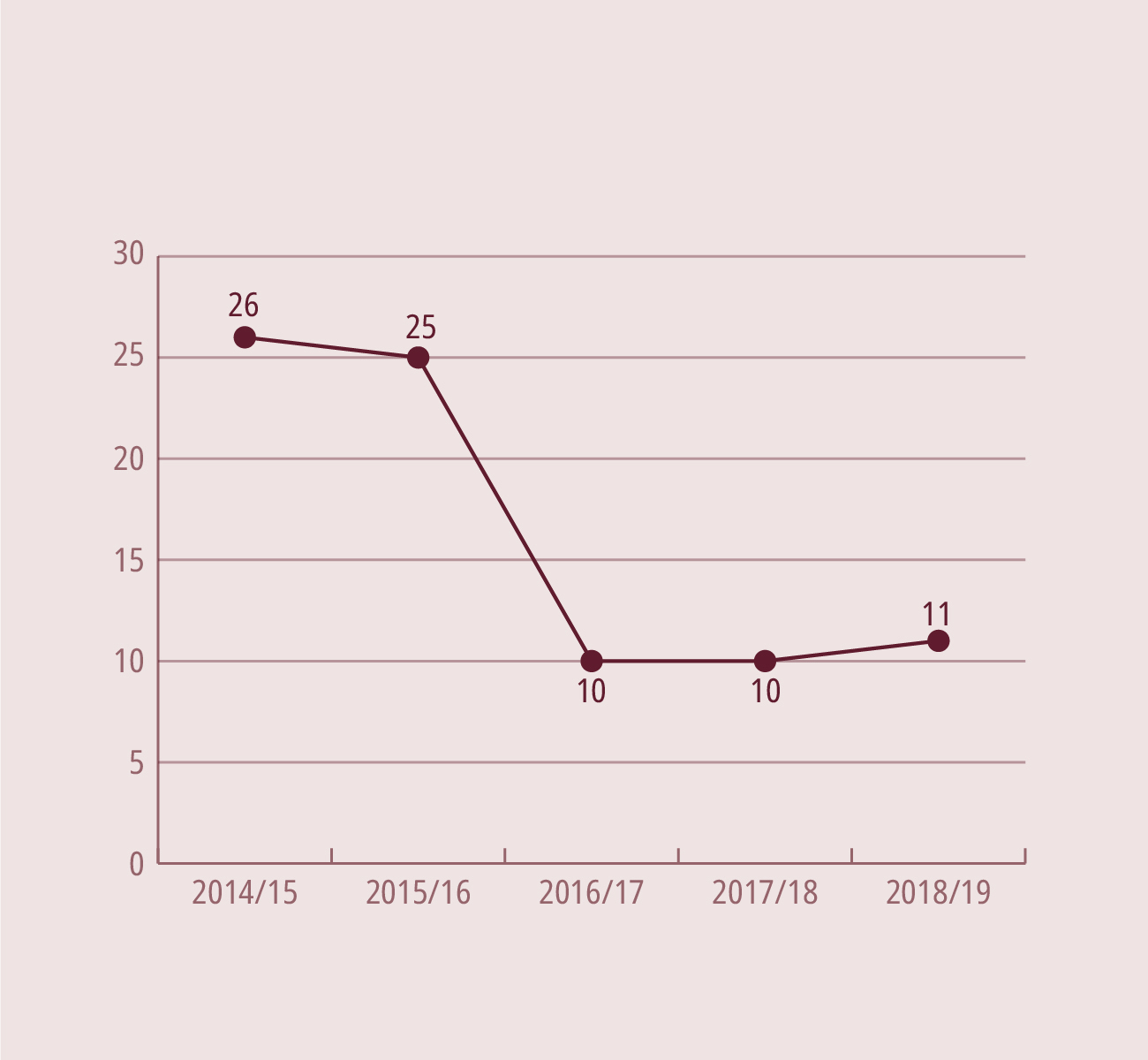
Figure 2-12: Graph breakdown
| 2014/15 | 2015/16 | 2016/17 | 2017/18 | 2018/19 | |
|---|---|---|---|---|---|
| Total Punishments of Detention | 26 | 25 | 10 | 10 | 11 |
Summary Trial Reviews
In the current reporting period, a total of 32 summary trials were reviewed based on requests by members found guilty at summary trial or on a review authority’s own initiative. Of a total of 533 summary trials, the percentage of cases that were subject to a review was approximately 6%. This percentage is slightly higher than that of the previous reporting period when approximately 4.63% of cases were reviewed. Of those reviews, nine were based on finding, 16 on sentence, and seven were based on both finding and sentence. Figure 2-13 shows the percentage of cases for which a review of the finding, the sentence or both were conducted since 2014-15.
Figure 2-13: Percentage of Summary Trials Reviewed
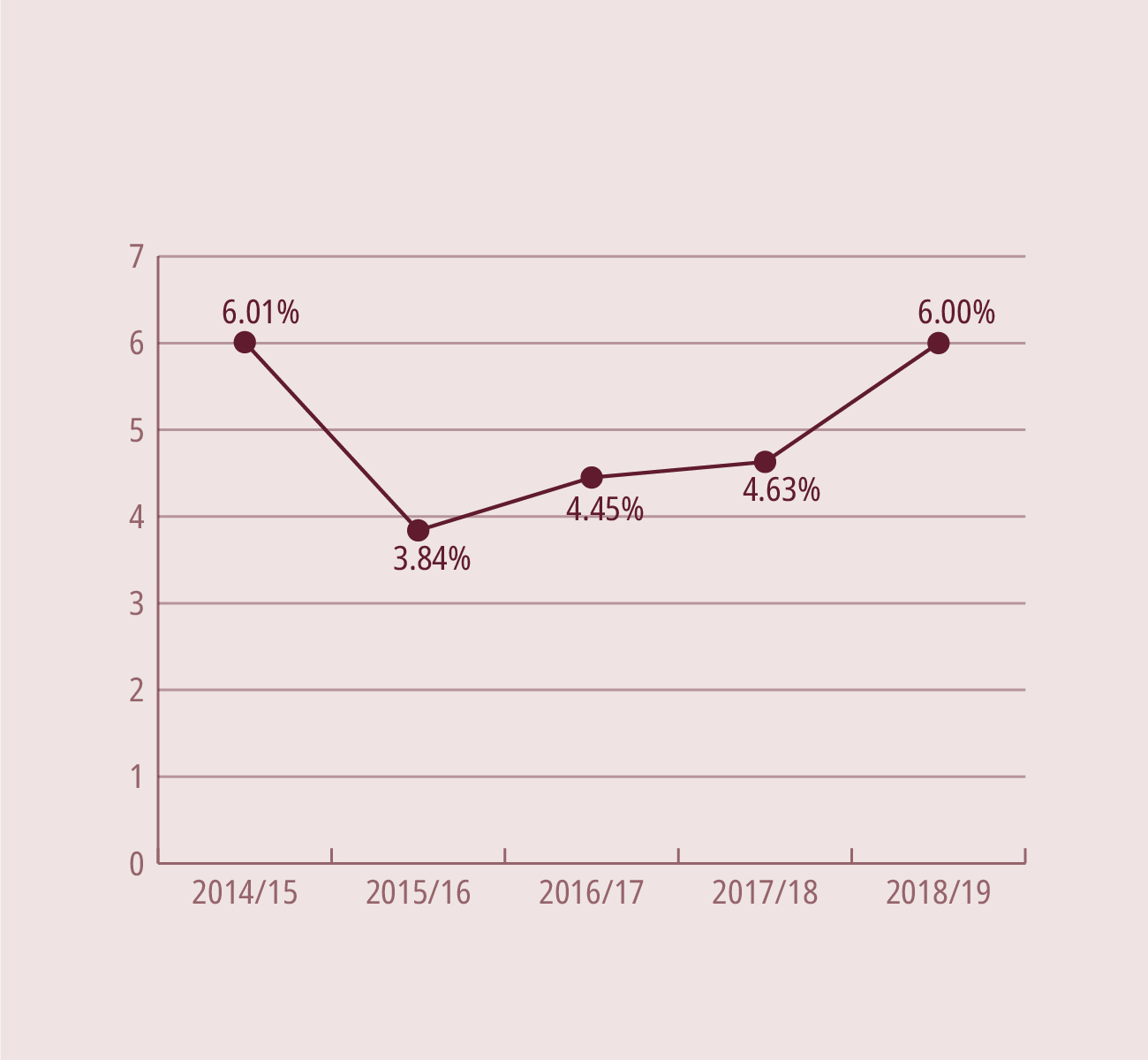
Figure 2-13: Graph breakdown
| 2014/15 | 2015/16 | 2016/17 | 2017/18 | 2018/19 | |
|---|---|---|---|---|---|
| Percentage of Summary Trials Reviewed | 6.01 | 3.84 | 4.45 | 4.63 | 6.00 |
Based on the nature of the request for review, a review authority has several options to deal with the matter, including upholding the decision of the presiding officer, quashing the finding of guilt, and substituting the finding or punishment. In approximately 31% of all decisions, a reviewing authority quashed the decision of the presiding officer. In approximately another 31% of all decisions, a reviewing authority upheld the decision of the presiding officer. In the previous reporting period, in approximately 58% of reviews, the review authority upheld the finding of the presiding officer. A complete breakdown of all decisions of a review authority and the corresponding percentage of each decision for the past two reporting periods can be found at Figure 2-14.Footnote 23
Figure 2-14: Decisions of Review Authority
| 2017-2018 | 2018-2019 | |||
|---|---|---|---|---|
| # | % | # | % | |
| Upholds decision | 17 | 58.62 | 11 | 31.43 |
| Quashes findings | 6 | 20.69 | 11 | 31.43 |
| Substitutes findings | 2 | 6.9 | 2 | 5.71 |
| Substitutes punishment | 1 | 3.45 | 5 | 14.29 |
| Mitigates / commutes / remits punishment | 3 | 10.34 | 6 | 17.14 |
| Total | 29 | 100 | 35Footnote 23 | 100 |
Harmful and Inappropriate Sexual Behaviour and Sexual Misconduct
At the summary trial level, Harmful and Inappropriate Sexual Behaviour and Sexual Misconduct are most frequently charged pursuant to section 129 of the National Defence Act, conduct to the prejudice of good order and discipline. In the current reporting period, there were a total of 35 charges for Harmful and Inappropriate Sexual Behaviour and Sexual Misconduct compared to 24 charges in the previous reporting period.
Of the 35 charges during this reporting period, there were 30 findings of guilt, three findings of not guilty, and two charges which were stayed. Two reviews were requested by the offender, one for a review of both the findings and sentence in which the decisions were upheld, and one request for a review of the sentence which was commuted by the review authority.
This is compared to the previous reporting period in which there were 18 findings of guilt, six findings of not guilty and one charge which was stayed. Four requests for review were conducted. Three at the request of the offenders for both the findings and the sentence in which the review authority upheld all decisions. One request was initiated by the review authority which resulted in the sentence being substituted.
Language of Summary Trials
As an accused may choose to have his or her summary trial conducted in either official language, the presiding officer must be able to understand the language in which the proceedings are to be conducted without the assistance of an interpreter. Where the presiding officer lacks the required language ability, he or she should refer the case to another presiding officer who has the required language ability to try the case.
In this reporting period, approximately 80% of summary trials were conducted in English and 20% were conducted in French. These percentages are consistent when compared to previous reporting periods. Figure 2-15 shows the number of summary trials conducted in both English and French for the past two reporting periods.
Figure 2-15: Language of Summary Trials
| 2017-2018 | 2018-2019 | |||
|---|---|---|---|---|
| # | % | # | % | |
| Number in English | 519 | 82.78 | 426 | 79.92 |
| Number in French | 108 | 17.22 | 107 | 20.08 |
| Total | 627 | 100 | 533 | 100 |
Timelines for Summary Trials
The purpose of the summary trial system is to provide prompt but fair justice in respect of minor service offences, and as such, these trials are required to begin within one year of the date on which the offence is alleged to have been committed, unless this limitation period is waived by the accused.Footnote 24
This reporting period, there were 533 summary trials and the average number of days from the last date of the alleged offence to the conclusion of the summary trial was approximately 99 days. Of those 533 summary trials, 314 were concluded within 90 days of the last date of the alleged offence, representing approximately 59% of all summary trials for the reporting period. Further, approximately 85% of all summary trials were concluded within 180 days of the last date of the alleged offence. Figure 2-16 shows a breakdown of the number of days from the last date of the alleged offence to the conclusion of the summary trial.
Figure 2-16: Number of Days from Alleged Offence to Conclusion of the Summary Trial for Reporting Period 2018/19Footnote 25
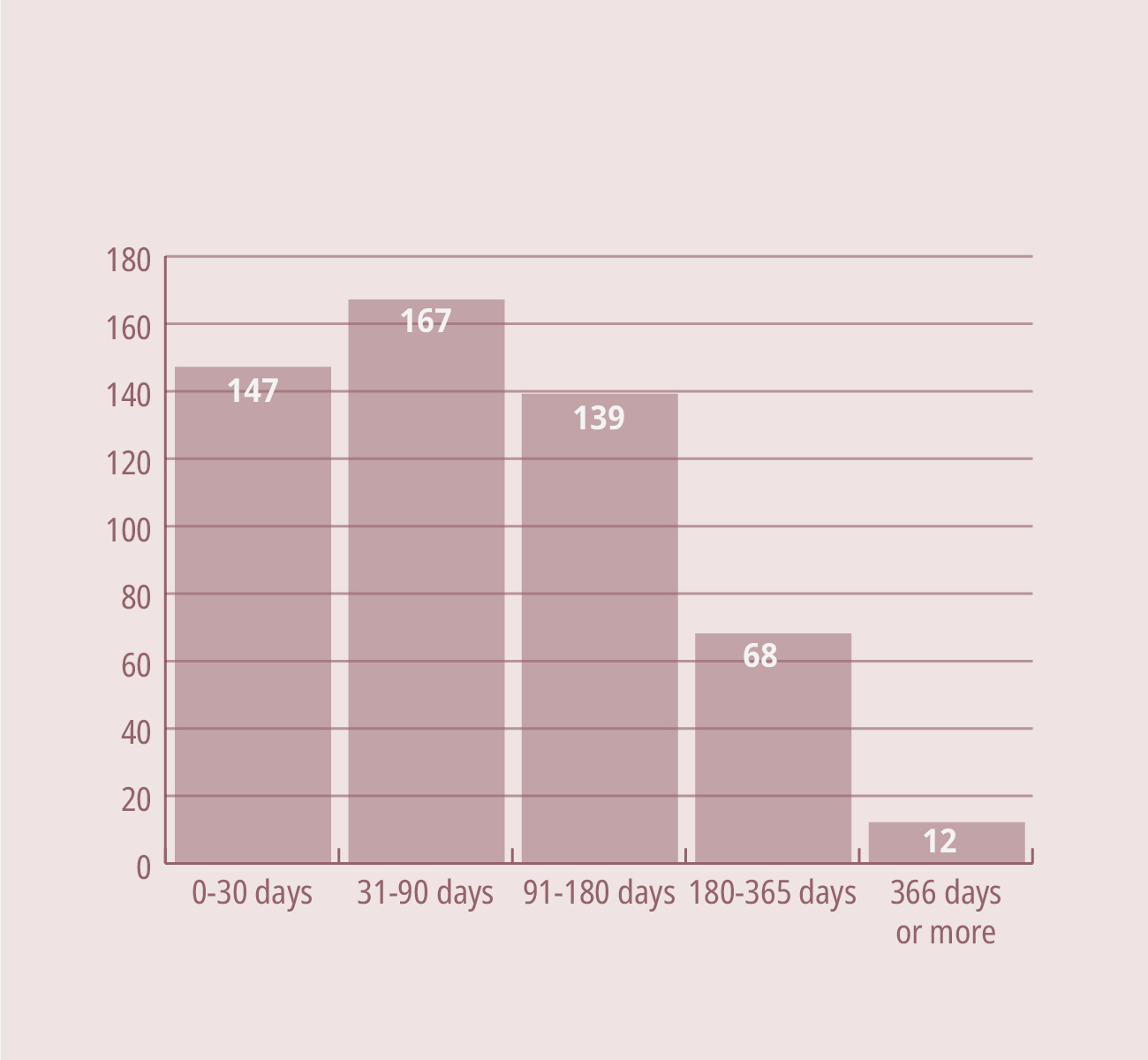
Figure 2-16: Graph breakdown
| 0-30 days | 31-90 days | 91-180 days | 181-365 days | 366 days or more | |
|---|---|---|---|---|---|
| Number of Cases | 147 | 167 | 139 | 68 | 12 |
Once a charge has been laid by the appropriate authority and is referred to a presiding officer, the presiding officer may be required to obtain legal advice before commencing the summary trial.Footnote 26 Once that advice has been received from the unit legal adviser, the presiding officer may commence the summary trial.
Over the past five years, the number of days between the time a charge is laid to the conclusion of the summary trial has fluctuated, reaching a low of 15.8 days in the previous reporting period. During the current reporting period, this number has increased to approximately 24 days. Figure 2-17 shows the average number of days from charge laid to the conclusion of the summary trial over the last five reporting periods.
Figure 2-17: Number of Days from Charge Laid to Summary Trial
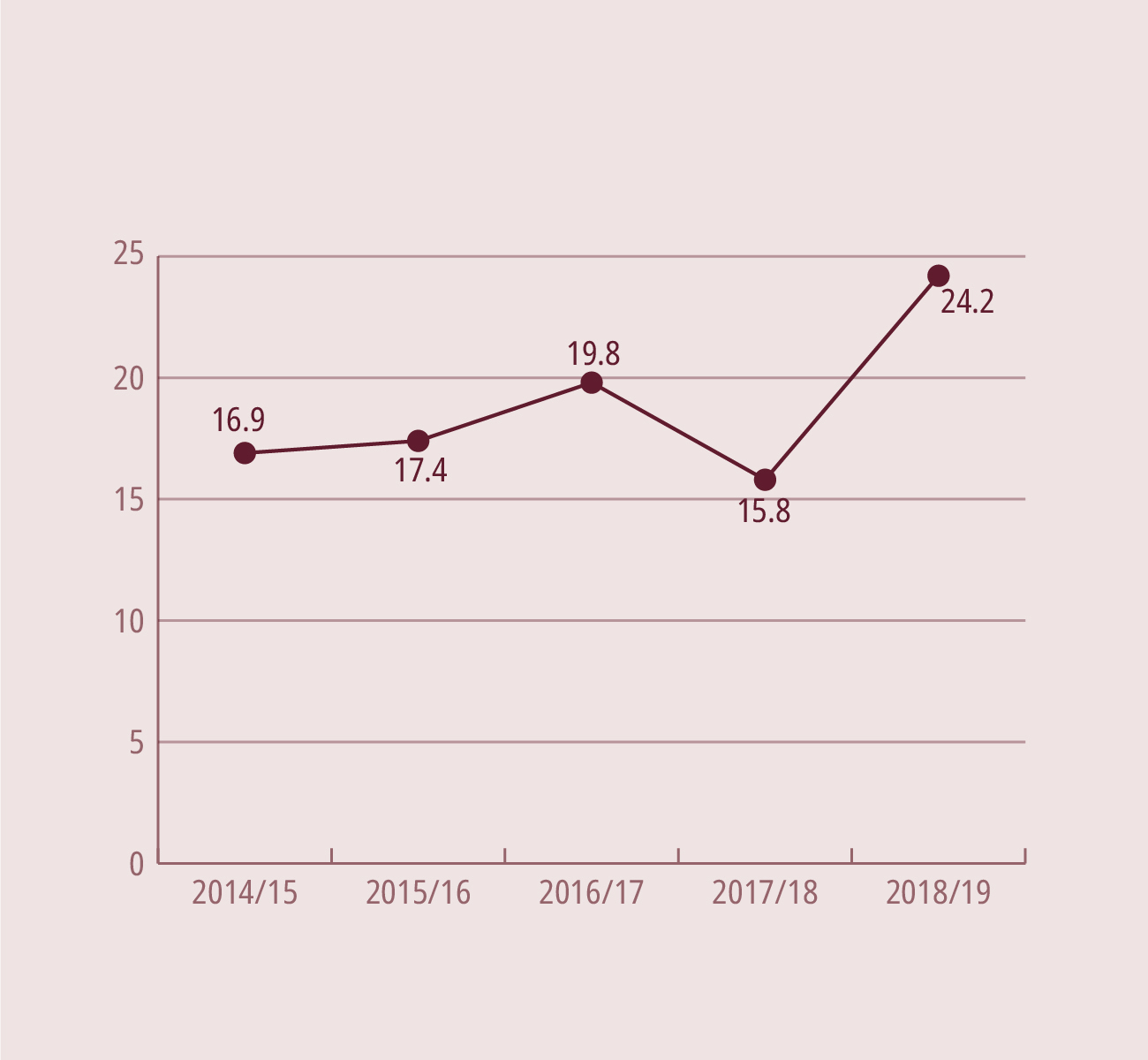
Figure 2-17: Graph breakdown
| 2014/15 | 2015/16 | 2016/17 | 2017/18 | 2018/19 | |
|---|---|---|---|---|---|
| Number of Days | 16.9 | 17.4 | 19.8 | 15.8 | 24.2 |
Courts Martial
Number of Courts Martial
During this reporting period, there were a total of 51 courts martial completed, representing approximately 9% of all trials held before service tribunals and remaining relatively consistent with the previous reporting period. Figure 2-18 demonstrates the number of courts martial by year since 2014/15.
Figure 2-18: Number of Courts Martial
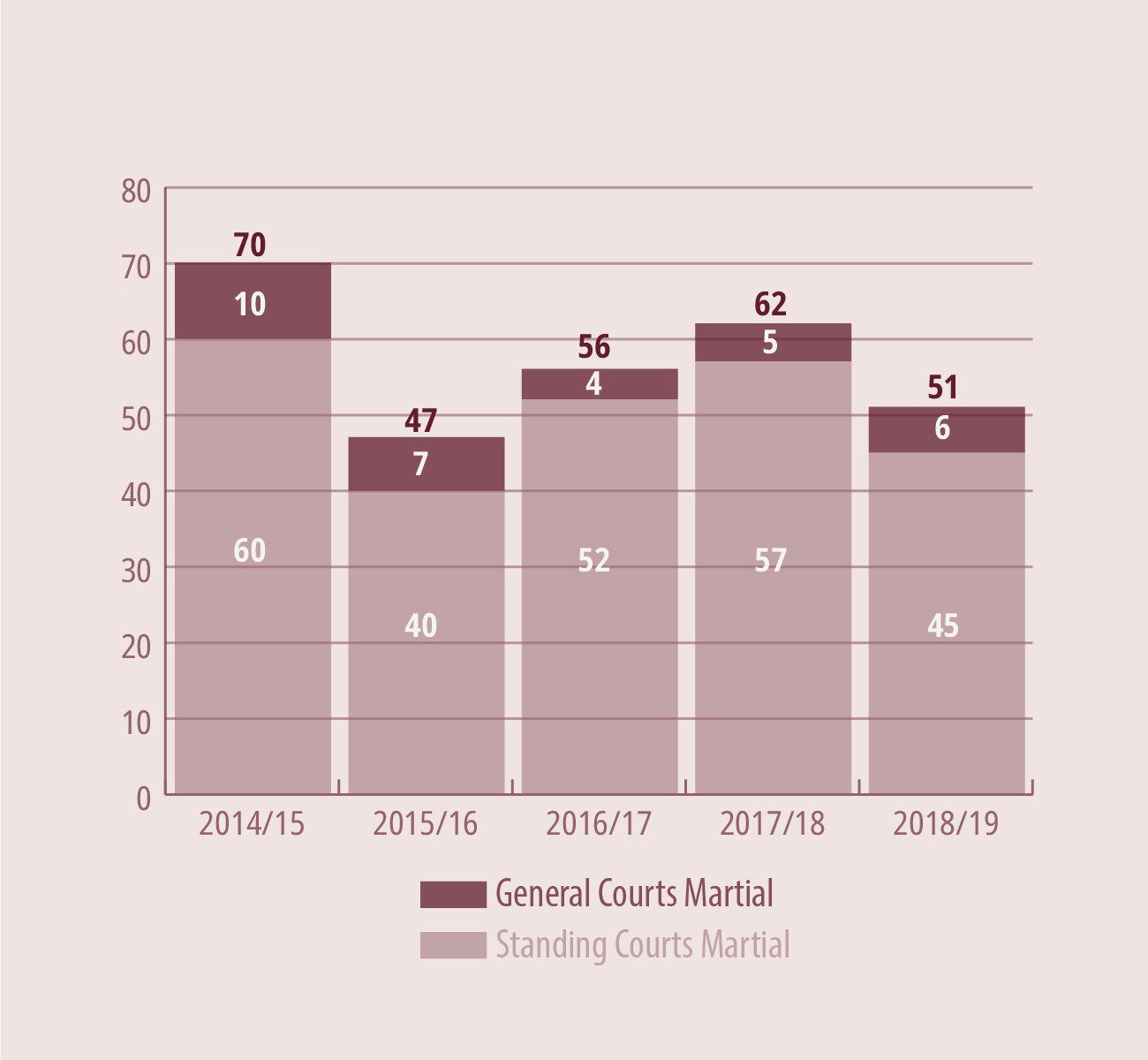
Figure 2-18: Graph breakdown
| 2014/15 | 2015/16 | 2016/17 | 2017/18 | 2018/19 | |
|---|---|---|---|---|---|
| General Courts Martial | 10 | 7 | 4 | 5 | 6 |
| Standing Courts Martial | 60 | 40 | 52 | 57 | 45 |
| Total | 70 | 47 | 56 | 62 | 51 |
Results by Case at Court Martial
Of the 51 courts martial held this year, 43 cases resulted in a finding of guilt on at least one charge and six cases resulted in a finding of not guilty on all charges. Figure 2-19 shows disposition by case over the past two reporting periods.
Figure 2-19: Disposition of Cases at Court Martial
| 2017-2018 | 2018-2019 | |||
|---|---|---|---|---|
| # | % | # | % | |
| Found Guilty of at Least One Charge | 51 | 82.26 | 43 | 84.31 |
| Not Guilty of All Charges | 11 | 17.74 | 6 | 11.77 |
| Stay of All Charges | 0 | 0.00 | 0 | 0.00 |
| Withdrawal of All Charges | 0 | 0.00 | 1 | 1.96 |
| Termination of Proceedings | 0 | 0.00 | 1 | 1.96 |
| Total | 62 | 100 | 51 | 100 |
Director of Military Prosecutions Case Management
Referrals
During this reporting period, the Director of Military Prosecutions received a total of 102 referrals compared to 118 in the previous reporting period, a decline of 13.56%. There were also fewer cases carried over from the previous reporting period, resulting in a total of 172 referrals processed in 2018/19 as compared to 199 in 2017/18, a decrease of 13.57%. Of these 172 cases, post-charge decisions were made by the Canadian Military Prosecution Service in 154 of them with the remainder carried over to the next reporting period.
Figure 2-20 shows the number of referrals received by the Director of Military Prosecutions over the last five reporting periods with a comparison as to how many were processed within each respective reporting period.
Figure 2-20: Number of Referrals
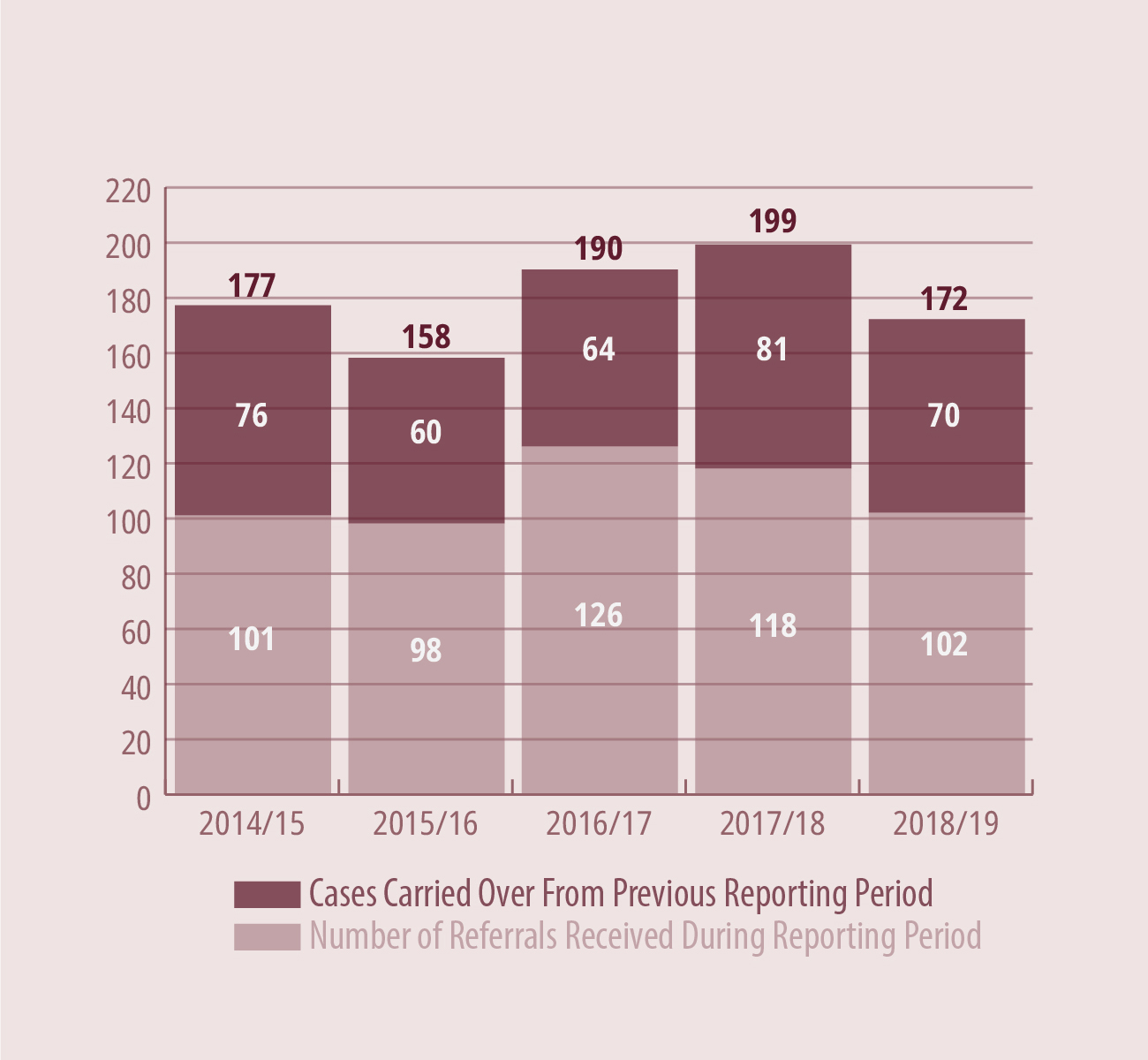
Figure 2-20: Graph breakdown
| 2014/15 | 2015/16 | 2016/17 | 2017/18 | 2018/19 | |
|---|---|---|---|---|---|
| Cases Carried Over From Previous Reporting Period | 76 | 60 | 64 | 81 | 70 |
| Number of Referrals Received During Reporting Period | 101 | 98 | 126 | 118 | 102 |
| Total | 177 | 158 | 190 | 199 | 172 |
Preferrals and Non-PreferralsFootnote 27
During this reporting period, there were 107 cases preferred for trial by court martial and 47 cases in which no charges were preferred. The percentage of cases preferred for trial by court martial for this reporting period was approximately 69%. Unlike the 2017/18 reporting period in which 55 files were preferred, or 57%, this reporting period saw a sharp rise in the rate of preferrals. In the past five reporting periods, the highest rate of preferrals was 69% during this reporting period and the lowest rate of preferrals was 57% in 2017/18.
Figure 2-21 illustrates the number of files pre-ferred by the Director of Military Prosecutions and the number of files where no charges were preferred over the past five reporting periods.
Figure 2-21: Number of Preferrals and Non-Preferrals
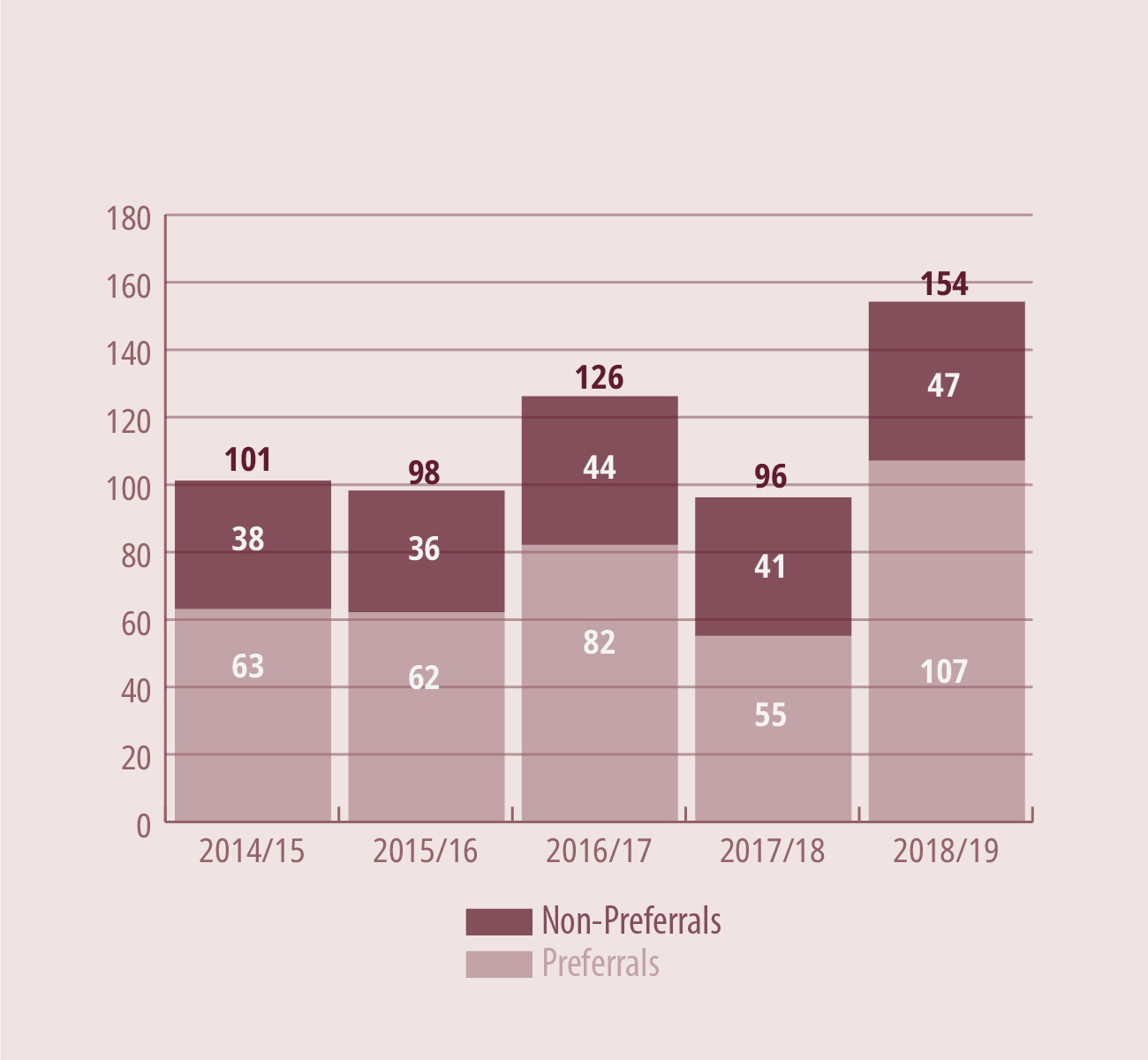
Figure 2-21: Graph breakdown
| 2014/15 | 2015/16 | 2016/17 | 2017/18 | 2018/19 | |
|---|---|---|---|---|---|
| Non-Preferrals | 38 | 36 | 44 | 41 | 47 |
| Preferrals | 63 | 62 | 82 | 55 | 107 |
| Total | 101 | 98 | 126 | 96 | 154 |
Timelines
During this reporting period, the average number of days from referral of a matter to the Director of Military Prosecutions until post-charge decision against an accused was approximately 88 days, a decrease of approximately seven days, or 7.37%, from the previous year. Figure 2-22 illustrates the average number of days from referral to post-charge decision over the course of the past five reporting periods.
Figure 2-22: Number of Days from Referral of File to the Director of Military Prosecutions to Preferral of Charges
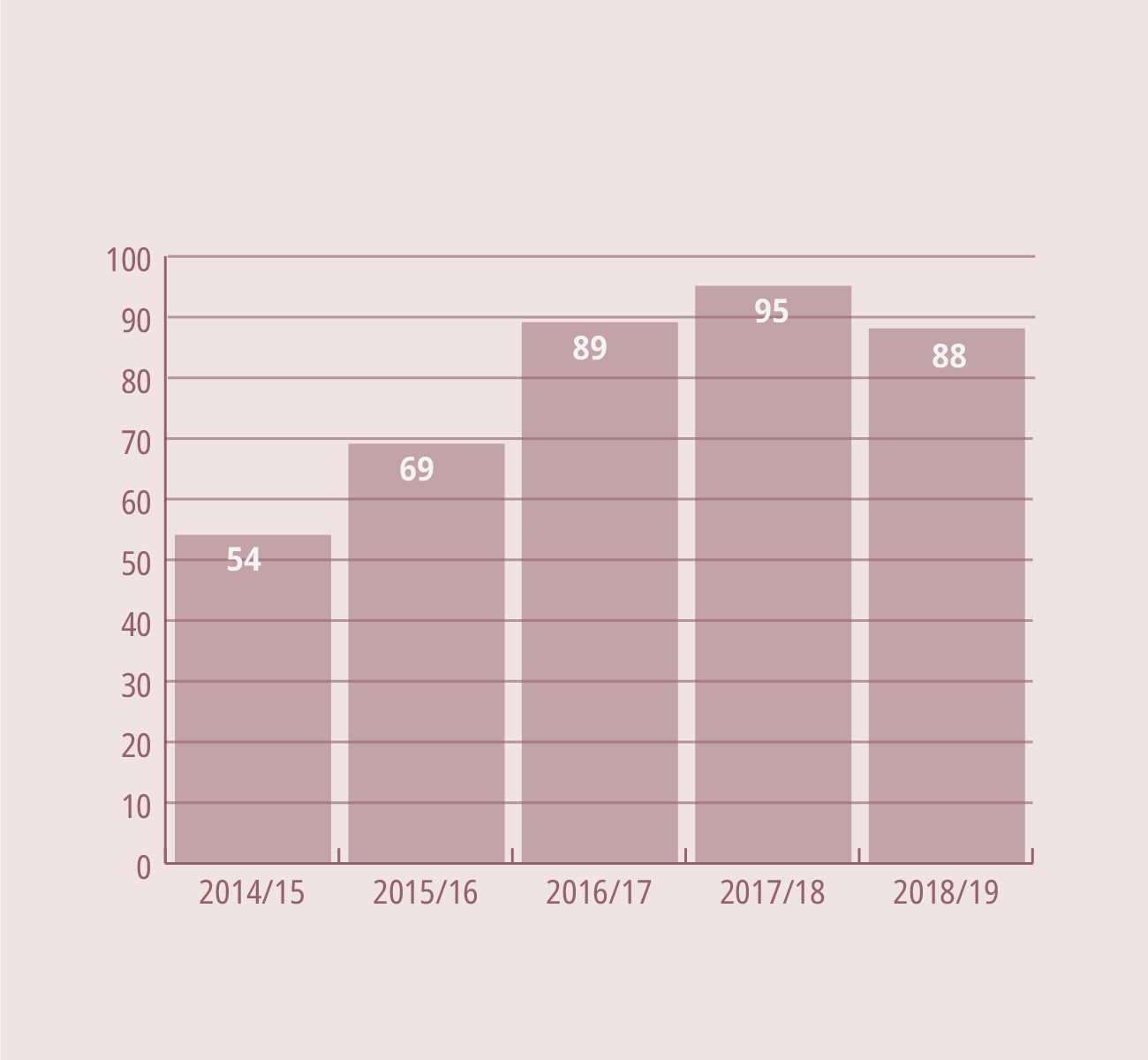
Figure 2-22: Graph breakdown
| 2014/15 | 2015/16 | 2016/17 | 2017/18 | 2018/19 |
|---|---|---|---|---|
| 54 | 69 | 89 | 95 | 88 |
During this reporting period, the average length of time it took for the commencement of a court martial following the preferral of charges against an accused was 244 days, an increase from the previous reporting period by an average of 33 days, or 15.64%. The total number of days from the preferral of a charge to the commencement of a court martial in the previous reporting period was 211 days. Figure 2-23 demonstrates the average length of time for a court martial to commence once charges against an accused were preferred over the course of the past five years.
Figure 2-23: Number of Days from Preferral of Charges to Beginning of Court Martial
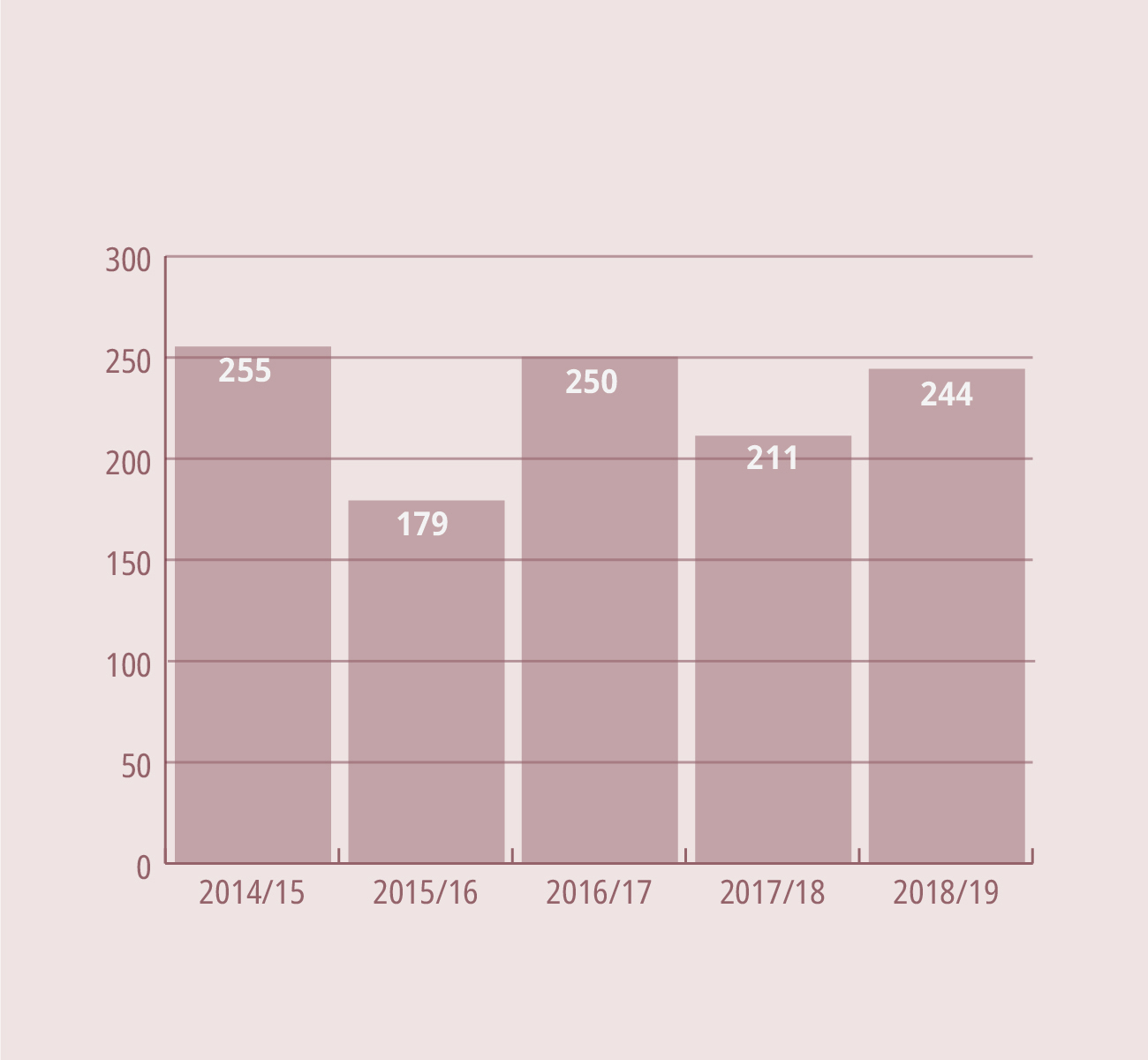
Figure 2-23: Long description
| 2014/15 | 2015/16 | 2016/17 | 2017/18 | 2018/19 |
|---|---|---|---|---|
| 255 | 179 | 250 | 211 | 244 |
Punishments at Court Martial
While only one sentence may be passed on an offender at a court martial, more than one punishment may be given as part of the sentence. In the 2018/19 reporting period, 43 sentences were pronounced by courts martial, involving a total of 57 punishments. The most common punishments imposed were fines, 35 in total, representing 61.40% of punishments, followed by 10 severe reprimands, or 17.54% of punishments. A total of four custodial punishments, representing approximately 7.01% of punishments, were imposed by courts martial, including three imprisonments and one detention, which was suspended. Figure 2-24 breaks down the punishments imposed by courts martial over the past two reporting periods.
Figure 2-24: Punishments at Courts Martial
| 2017-2018 | 2018-2019 | |
|---|---|---|
| Dismissal | 3 | 2 |
| Imprisonment | 7 | 3 |
| Detention | 4* | 1** |
| Reduction in Rank | 9 | 2 |
| Severe Reprimand | 11 | 10 |
| Reprimand | 20 | 4 |
| Fine | 38 | 35 |
| Confinement to ship or barracks | 1 | 0 |
| Stoppage of leave | 1 | 0 |
| Caution | 1 | o |
| Total | 95 | 57 |
| * The execution of three of these punishments were suspended. ** The execution of this punishment was suspended. |
||
Sexual Misconduct
A total of 20 courts martial dealing with sexual misconduct charges were completed during this reporting period with 14 of those resulting in a finding of guilt on at least one charge. There was the same number of courts martial dealing with sexual misconduct charges during the 2017/18 reporting period with 14 of those resulting in a guilty finding, one court martial resulting in a guilty finding of a lesser and included offence and five courts martial resulting in findings of not guilty.
Director of Defence Counsel Services Representation
When a person appears before a military judge, a court martial, the Court Martial Appeal Court or the Supreme Court of Canada, they may have the right to be represented by counsel assigned by the Director of Defence Counsel Services at public expense or they may retain civilian counsel at their own expense or choose to self-represent.
During this reporting period, the Director of Defence Counsel Services provided legal representation to accused persons in 170 referred files, which included 82 cases from the previous reporting period. Of these 170 files, 96 were completed during this reporting period. Of the completed files, 51 members had the charges withdrawn without proceeding to a trial but requiring some level of legal representation by the Director of Defence Counsel Services. The remaining 45 cases resulted in four cases where the accused was found not guilty on all of the charges, one case which was terminated by a military judge and 40 cases in which the accused was either found guilty or pled guilty to at least one of the charges.

